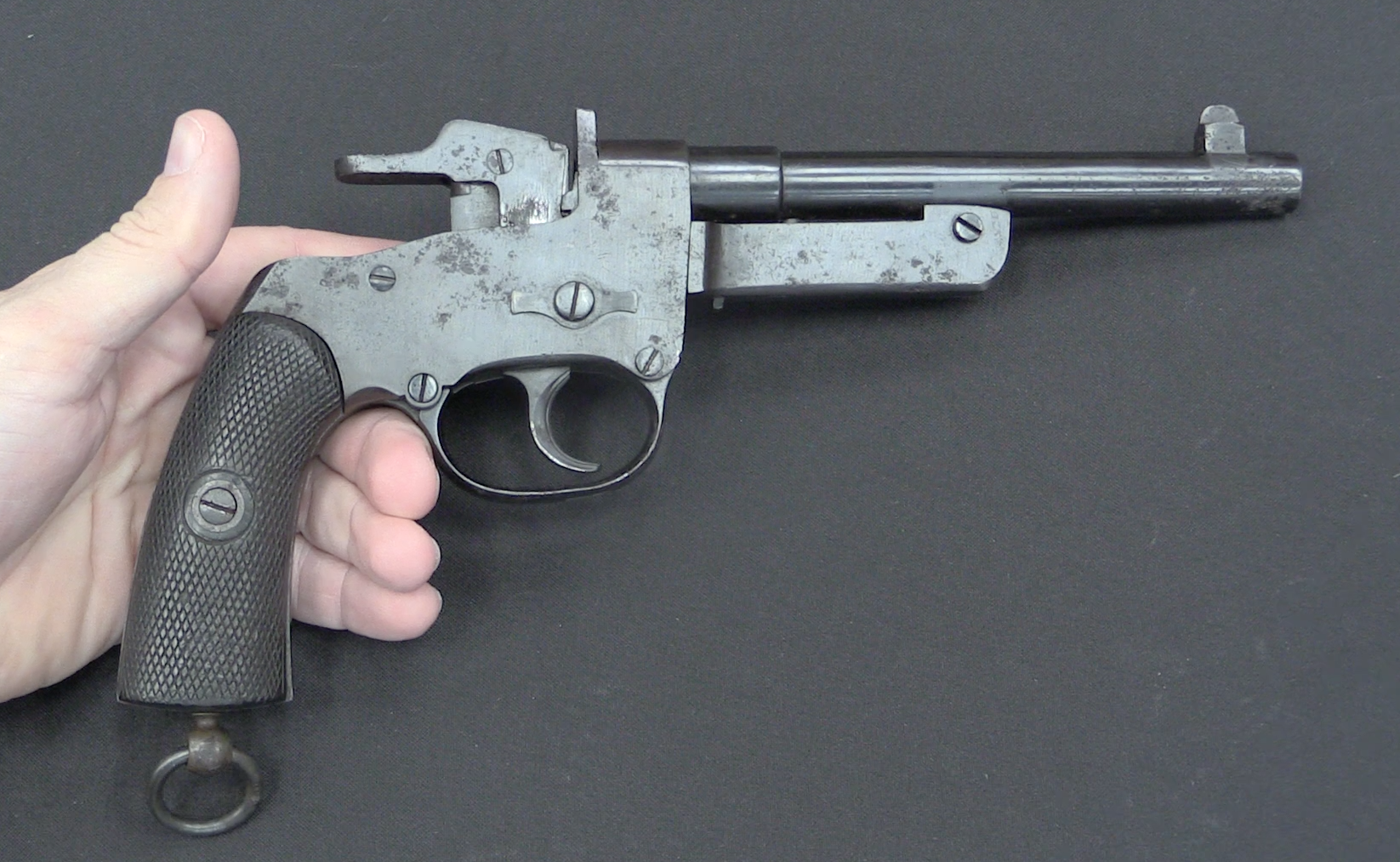Yesterday we took a look at the mechanics and history of Heinrich Vollmer’s 1930 pattern VMP, and today we have it out at the range. I’m curious is the mid-point monopod will actually help or hinder accurate shooting…shall we find out?
Related Articles

Bolt Action Rifles
Vintage Saturday: Trench Mag



Uncategorized


One of the great things about Forgotten Weapons is the way shooting the weapons reveals outcomes that can differ radically from a simple desk top analysis. Long may Ian keep up his good work!
IAN! Why didn’t you put a shooting mat or cloth down? Someone will be paying big bucks for it soon, and you stick it right in the dirt! I know my CIII stuff where all on battlefields, but I don’t take Thompsons out in the rain.
Brings up questions I’ve long wondered about.
* Who do you ask / who gives permission to fire these auction guns — the auction house and/or the owner?
* What happens if a gun breaks or is damaged during disassembly, assembly, or shooting? Does insurance cover it? Does Ian never get invited back?
That’s what cleaning and oil are for .
You can see why, during the interwar period, there was a belief that an SMG might fill the bill as a squad automatic. Thus the “heavy submachinegun” concept. Considering the short range of so much infantry fighting, you can see why some people hoped that a sturdy, easy-shooting pistol caliber automatic shoulder weapon was what they needed — especially in times of stingy budgets.
And I still want Ian to shoot a few 100-meter groups for us with a selection of those interwar irons.
One observation I made was that the central location of the monopod made it easy for Ian to swing the barrel laterally. The Germans often put bipods at the back of machine gun barrels for this reason, and designed the MG42 to have optional mounts at the back and front. Now the situation you’re describing, where an enemy attacks at close range, would require a squad automatic to have a wider arc of fire than at the ranges we associate with machine guns. Perhaps this was not an accident.
I wonder how many folks on this board have seen any active service? IE fired any weapons ‘in anger’, as this jungley old Auzzie former marksman is asking?
Just in case, I and some other such HATED the M60GPMG. Yes it had a change-able barrel, but no handle and a glove in the bag with the spare barrel. The silvery bag being a great way to identify an MG team.
Now I know that the USN’s ordinance bureau was HOPELESS in WWII, hence the Mk14 torpedo!! LOL and ROTFLMAOff!
But it seems likely that the US Army’s B of O was responsible for ‘The Pig’ as it is rightly known(aka M60GPMG) as it is rightly known. A gas piston you could put in the wrong way around. A 100 rd belt – FOR an infantry section MG!!!!!!!. Don’t mention the belt bag. Which has such strong attachment devices that they fell off, ALL the bloody time!!
I read somewhere that you have adopted the MAG58 designed by FM but of course it HAS to be renamed and renumbered the MG240. WE cant let OUR US CITIZENS know THAT we cant make a decent GPMG now, can we!?
Just as the USN’s ordnance bureau – FINALLY – got a kick up the arse over the Mk14 – so should the US Army’s B of O have got one for the PIG!
The ONLY way to get good weapons for your services is to post front-line weapons experts. Senior NCOs and attach them on rotation to keep the Bureau’s sensible and give them the powers they need to stop things like the Mk14 and M60 happening, ever again. Field test or SEA test and Air test the messed-up little bastards.
Our Infantry went ape-shit HAPPY when we got the L4 LMGs (Brens barrelled for 7.62 Nato) as interims for the FN-MAG58. I was THERE!
As a tax-paying American, I can say with great certainty that the military’s small arms procurement system is broken beyond repair. That is mostly because the nitwits in charge of arms development have political backing and lobbyists to help keep them from being fired. Basically, since there is nobody else qualified to do the job, you can’t fire them. Or so they claim.
Timothy, relax.
If you look at older threads in this forum, you will find messages by contributor kirk, which basically are in agreement with most things you mention.
Be assured, the problem of requirements written by people ignorant of what is required, is not just a U.S. problem. Since the end of the cold war, the West has the additional problem that small arms manufacturers have gotten rid of the “costly” people who really knew how to design small arms. Double trouble.
The German MG5 is an outstanding example. Based on totally wrong requirements, industry delivered a gun. The design was not at all up to the task, as the countless changes in important components shows. For example, the central recoil spring had to be replaced by two smaller springs on the sides (P38-like) and the receiver had to be made significantly stronger to avoid cracks. Announced as significantly lighter that the MG3, it is now heavier. In my view, these fundamental changes indicate that the designers were strangers to the loads encountered in automatic weapons.
To me it looks like the M60 has found a worthy successor in the MG5.
Honestly speaking, they should just stick to MG3, MG5 is pathetic compared to its predecessor. And MG5 cannot use DM1 belt like WTH.
Better just get PKM then
“(…)DM1(…)”
If you need newer machine gun than MG3 and of German origin supporting this feature then use HK 21 http://modernfirearms.net/en/machineguns/germany-machineguns/hk-21-i-23-eng/
I’d honestly have to state that the “worthy successor” to the M60 would have to be something far worse than the MG5. The MG5 is a workmanlike response to a misguided set of requirements laid out by people who’ve apparently completely forgotten (or, who never knew…) German MG doctrine. Which was distinctly different than the rest of ours, across NATO.
Some bureaucrat, not an actual tactician or practicing soldier, chose those requirements in conformity with “the rest of NATO”, not knowing what they were doing. I don’t doubt but that some bright light will likely re-discover all of the old-school German MG tactics and doctrine, and then some other idiot will pay them big money for the privilege of having it showered upon them, yet again.
“(…)looks like the M60 has found a worthy successor in the MG5.”
Can you assembly it wrongly, so it would become repeating rifle? Is it forbidden to close cover at certain bolt position? Is it to prone to going for above full-auto mode (firing until ammunition depleted, even if trigger released earlier)?
“(…)central recoil spring had to be replaced by two smaller springs on the sides (P38-like) and the receiver had to be made significantly stronger to avoid cracks(…)”
I do not consider these changes to make MG5 as bad as M60. Important changes do happen even for less sucking weapon, take for example M1 rifle, which as adopted sported so-called gas-trap https://www.thearmorylife.com/whats-a-gas-trap-garand/ and DP machine gun which has spring in wrong place (prone to heat) which was repaired in DPM. Real question: was MG5 tested enough/why issues were not detected?
Crusty old Australian Warrant Officer once commented to me that the M60 being inflicted upon Australia by the US was absolutely and unequivocally not the sort of thing that one should expect from a respected and respectable ally. Moreover, it should have been seen as a legitimate act of perfidy, grounds for a declaration of war.
Ruefully, I have to acknowledge that the man had a point. Only thing I can say in defense is that we issued the same POS to our own, and kept it in service well past its “best by” date.
Honestly, they ought to be giving you those nuclear subs for free, in expiation.
Might I reinforce, yet again, that I really, devoutly just loathe the M60?
Don’t care IF they get my EMAIL
tim-bailey@grapevine.com.au